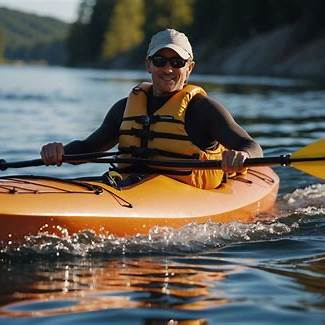Most people use “life jacket” and “PFD” interchangeably—but they’re not the same. Choosing the wrong gear can leave you under-protected in rough water or over-burdened in calm conditions. In the next few minutes you’ll learn the real difference between life jackets and personal flotation devices (PFDs), when to use each, and how to meet U.S. Coast Guard (USCG) rules while staying comfortable on the water.
What Is a Life Jacket?
A life jacket is a Type I or Type II wearable approved by the USCG. Its high buoyancy turns most unconscious people face-up, keeping airways clear even in rough, offshore conditions. Typical features include:
- Thick, inherently buoyant foam
- High collar or full-neck design for head support
- Bright colors and reflective tape for visibility
- Minimum 22 lb (Type I) or 15.5 lb (Type II) of buoyancy
Best for:
- Offshore sailing or commercial vessels
- Cold, remote, or heavy-sea environments
- Anyone who might lose consciousness (e.g., medical conditions, night shifts)
Related keyword: life jackets for adults—because adult sizes carry the highest buoyancy and are mandatory for many commercial crews.
What Is a Personal Flotation Device (PFD)?
A personal flotation device is any wearable flotation aid that does not guarantee face-up turning. Most recreational models are Type III or Type V:
- Type III (“life vest” or “buoyancy aid”) – lighter, slimmer foam or inflatable chambers; designed for conscious wearers who can tilt their heads to breathe.
- Type V (“special-purpose”) – activity-specific gear such as inflatable belt packs, kayak fishing vests, or sailing harness PFDs; legal only when worn for the stated activity.
Because they’re flexible and cooler to wear, PFDs dominate water sports like kayaking, stand-up paddleboarding (SUP), fishing, or coastal day-trips.

Key Differences at a Glance
| Feature | Life Jacket (Type I–II) | PFD / Life Vest (Type III–V) |
|---|---|---|
| Buoyancy | 15.5 – 22+ lb; auto face-up | 15–22 lb; wearer must tilt head |
| Comfort | Bulky; limited arm movement | Slim, ergonomic, breathable |
| Intended Use | Offshore, cold, rough or commercial waters | Recreational, near-shore, water sports |
| USCG Label | “Lifejacket – Type I/II” | “Wearable PFD – Type III/V” |
| Pros | Maximum survivability; turns unconscious | Lightweight; high mobility; specialty designs |
| Cons | Hot, restrictive, heavier | Won’t turn unconscious; activity-restricted |
Which One Should You Choose?
1. Offshore or Commercial Boating
Pick a Type I life jacket. Regulations require the highest buoyancy and self-righting ability for blue-water workboats, tankers, and ocean fishing charters.
2. Near-Shore Power-Boating
A Type II or Type III is usually acceptable—check state rules. Children under six on vessels < 26 ft must wear a USCG-approved PFD at all times in many states.
3. Paddle Sports (kayak, SUP, canoe)
Choose a slim Type III or a kayak-specific Type V with large armholes and a high back that clears seat rests. Look for mesh ventilation if you paddle in warm climates.
4. Water Sports (wakeboarding, tubing)
A snug Type III vest rated for impact will protect ribs and stay put in high-speed wipeouts. Inflatable belts are not allowed for these activities.
5. Cold-Water or Rescue Teams
Consider hybrid PFDs with automatic inflation plus inherent foam—warm, yet still self-righting if the CO₂ fails.
Legal Check: Every boat must carry at least one wearable PFD per person plus one throwable Type IV device if the vessel is 16 ft or longer.
Regulations differ worldwide; always verify local laws.
Common Myths & FAQs
“Are all PFDs life jackets?”
No. All life jackets are PFDs, but only Types I–II (and some Type V hybrids) guarantee face-up flotation for an unconscious wearer.
“Can I use a life vest instead of a life jacket offshore?”
A standard Type III life vest is not compliant for offshore or commercial use. It lacks the turning force of a life jacket and may fail in heavy seas.
“Are inflatable PFDs safe?”
Yes—if they’re USCG-approved and the cylinder is armed. Inflatables are never legal for:
- Children under 16
- High-impact sports (towing, white-water)
- Non-swimmers
“How long does a PFD last?”
Foam models last 10+ years when rinsed and stored dry. Replace inflatables every 5–10 years or if a fabric tear, mold, or failed arming indicator appears.
Our Recommendations
Ready to upgrade your water-safety kit? JIEKANG manufactures a full line of certified flotation gear:
- Life Jackets for Adults – Type I-II designs with 22 lb of buoyancy and reflective SOLAS tape.
- Sport PFD Life Vests – Breathable Type III vests for kayaking, fishing, and SUP.
- Custom Colors & Logos – Match your club branding or team uniforms.
- ISO & CE Certifications – Global compliance for international fleets.
Our products carry a one-year warranty and lifetime maintenance service—so you never have to compromise on safety or budget.
Conclusion & Next Steps
A life jacket and a PFD serve the same purpose—keeping you afloat—but the difference between life jackets and PFDs lies in buoyancy, comfort, and legal scope. Choose based on your activity, environment, and regulatory requirements:
- Offshore or rough waters → Life Jacket (Type I–II)
- Recreational paddling, warm weather → PFD / Life Vest (Type III–V)
Browse our collection of certified flotation devices and request a free catalog to equip your crew with gear they’ll actually wear. Your next adventure—or rescue mission—deserves nothing less than proven protection.
JIEKANG Medical Equipment Co., Ltd. has supplied rescue teams in 45+ countries since 2012. With rapid production, global shipping, and customizable options, we make professional-grade safety affordable.
👉 Request a Quote or Download Our Product Catalog
Stay safe, stay afloat, and let JIEKANG handle the rest.



